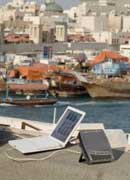Sur les chemins du monde

Etape English | Technology
The brain of the expedition
The brain of the expedition is called PowerBook G4 (or perhaps MacBook in 2007). We will have two portable Macs which will allow us to do almost anything, except the washing up. The 2 machines will be identical. They will both be equipped with the same programs in order to be prepared for any eventual breakdowns. In a few seconds, they can be transformed into a radio studio, a TV, or a graphical station for broadcasting sounds, pictures and texts from all around the world. Pushed to its limits, the Mac is the technical centre of our production.
Despite the two Macs being identical, Géraldine’s computer will be used mainly to manage audio and radio production, while Yann’s computer will be the video setup station as well as the filing cabinet (storage place) for pictures.
Communications
 For international communications, our nerve centre will be a BGAN inmarsat system. A concentration of sophisticated technology connected to a terminal of only a few hundred grams allows us, at any given time and from any possible location in the world, to benefit from:For international communications, our nerve centre will be a BGAN inmarsat system. A concentration of sophisticated technology connected to a terminal of only a few hundred grams allows us, at any given time and from any possible location in the world, to benefit from:
For international communications, our nerve centre will be a BGAN inmarsat system. A concentration of sophisticated technology connected to a terminal of only a few hundred grams allows us, at any given time and from any possible location in the world, to benefit from:For international communications, our nerve centre will be a BGAN inmarsat system. A concentration of sophisticated technology connected to a terminal of only a few hundred grams allows us, at any given time and from any possible location in the world, to benefit from:
- a low debit telephone for vocal communications destined to organisational matters
-an ISDN 64k telephone for direct audio transmissions with studio sound quality
-an broadband internet connection to send emails and internet contents, to answer astronauts, and to search for information.
-an average debit stream to broadcast live pictures and sounds
Internet:
Managing internet site content from any place in the world. Texts, pictures, sound bites and videos will be processed on the Macs and then be sent via ftp to the Paris server. The French production team changes the site, puts it up to date and manages its content.
In TV
All TV reports are filmed with a professional Sony HDV Z1 camera, completely equipped with wide scope, HF diversity microphones, an all use model that demonstrated its sturdiness and image quality. All filming will consequently be done in HD 16/9 to provide maximal quality. The compactness of this filming equipment allows us to pass for tourists without any major problems. The assembling will be done on the Mac with the Final Cut Pro HD software. External discs with high storage capacity allow the numeration of all our pictures to set up our reports repatriated in Europe by plane. The videos destined for the internet site are also encrypted by Flash Video and sent via ftp.
In radio:
Sound recording is made with the use of a card flash audio recorder.
The set up is done with Traktion de Mackie software. The texts are stored with the help of a professional mixing interface, used as pre amply microphone, as mini mixing device and as USB audio transformer. The USB pré is an impressive sound device. Encrypted in Wave and MP3 format, these reports are sent via internet.
Written texts
In order to minimise the time preceding the broadcasting of programs, the entire chain of production “fixed image” is entirely digital. As viewing box we use the new Canon EOS D5 with a 16-35mm 2,8 zoom and a 70-210mm 2.8.lens. It is supplemented with a Canon G5. The processing is made with the use of Photoshop and the pictures are sent to the newsroom via email. The editorial staff of Free Lens TV also receives texts and pictures to supply the internet site.















